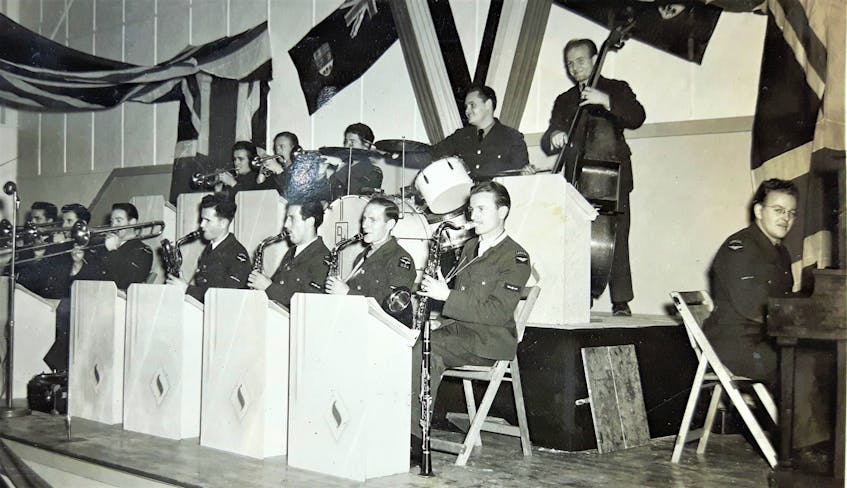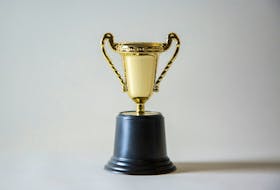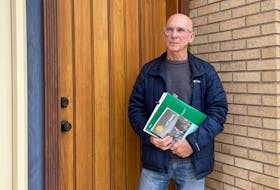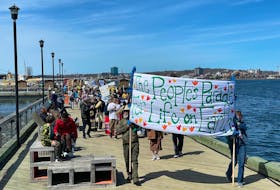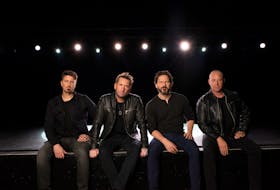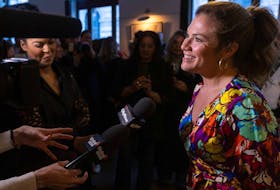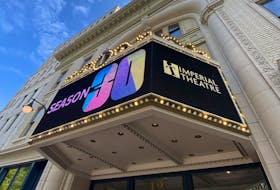American bandleader Glenn Miller called them the best band he had ever heard.
During the Second World War, the (Royal Canadian Air Force) RCAF Streamliners played hundreds of shows for military personnel across continental Europe and the United Kingdom.
Once the war was over, some of the band’s members went on to play with luminaries in the music business.
But it was in Gander where the RCAF Streamliners refined their sound and became a better band.
“They did nothing but practice in Gander,” said surviving bandmate Leonard Coppold.
Coppold first played with the Streamliners when he was stationed in Ontario but they parted ways shortly before the band left for Newfoundland.
“For five years, they streaked across the sky like a meteor,” said Andy Sparling.
He came across them again in Northern Ireland during one of the group’s stops. Coppold played a couple of sets with the band and then they parted ways again. That was until bandleader Bill Carter pulled some strings and got the now 98-year-old jazz guitarist posted at the same location as the Streamliners.
In short order, Coppold rejoined the band. It wasn’t long before he saw and heard how having that time in Gander had helped them come together.
“I saw a difference in them. They were more matured as a band,” he said. “Their music book was modern for its day.”
According to Andy Sparling's book, "Dancing Through The Darkness," the Streamliners arrived at the Gander Royal Canadian Air Force Base in late September 1943. Sparling's father, Phil Sparling, was a founding member of the band.

Made up of top-notch musicians from across the country who were stationed together, the band stayed in Gander until July 1944, when they headed to Ottawa for a two-week leave before heading overseas.
Their time in Gander was a non-stop mixture of rehearsals, dances, concerts — Christmas and otherwise — and funeral services.
“Gander was the place where it really jelled,” said Andy Sparling in an interview. “There was so much playing and rehearsing.”
Eileen Elms was six years- ld when her father moved from St. John’s to Gander to take a job at the military base there.
She was 10 when the RCAF Streamliners came to town.
Now 87, Elms remembers the dances, the shows and seeing the military and Air Force bands playing during parades in her youth.
While she doesn’t remember the names of the bands she saw — names can sometimes escape you when you’re 10 and fun is happening all around you, she noted — she remembers them being very good and the shows being a welcome break.
“They were marvelous,” Elms said. “They would play at a Christmas party for the children.”
Finding love

One member of the Streamliners found love in Gander.
Vocalist George Lane met his future wife at a dance at the Ernest Harmon Air Force Base in Stephenville, although it isn't clear if he was with the Streamliners when he first met Hazel Winsor of Corner Brook.
Winsor arrived at the base in Stephenville from Corner Brook via train with her sisters and some friends.
On a whim, they decided to check out the band. Hazel probably didn't realize she was checking out her future husband as well.
"It's where Dad fell in love with Mom," said son Gary Lane from St. John's.
George, a Windsor, Ont. native, and Hazel hit if off and kept in touch. Before the summer was over, George convinced Hazel to meet him in Truro, Nova Scotia by train before they headed off to Windsor to be married.
Afterwards, Hazel stayed with her in-laws while George went overseas with the band.
Coming together

Sparling’s father Phil, a former professional musician, joined the military in 1941 and began training to be a rigger (an airplane structure mechanic) at RCAF Technical Training School in St. Thomas, Ont.
In July that year, Phil — a saxophonist — was recruited into the dance band by trumpeter Bill Carter. Others, like bassist Jack Fallon, drummer Don Hilton, saxophonist and arranger Pat Riccio, as well as trombonist Mel Smith, joined shortly thereafter.
In total, the band was comprised of 17 jazz musicians from across Canada. First, they jammed in Ontario and played their first show together on July 25, 1941. It was a dance at the Masonic Temple in St. Thomas for the Corporals’ Mess. Their performances would become regular occurrences on Saturday nights after that.
“They had a sound all of their own,” said Andy Sparling.
Overseas
The Streamliners arrived overseas on Aug. 20, 1944, and were originally billeted in London at the Bedford Hotel.
They started rehearsing almost immediately as it was an important job to entertain the troops for the remainder of the war, which they did at the Finsbury Army Barracks in the city.
They toured bases in Cornwall, Devonshire and Wales. They also hit camps in Belfast and Yorkshire.
During the Baby Blitz that summer, the Streamliners would play shows in Lincoln’s Inn Fields Park in London as crowds gathered despite the threat of German bombs.
From December 1944 to January 1945, they visited troops on the frontlines in Holland, Belgium, France and England close to German forces.
Still, they went.
“I was worried for myself and I was worried for my guys, too,” said Coppold.
After the war was finished, they did a 40-show tour of Germany, hitting places like Hamburg — at the opening of the Canada Club — and Kiel.
This was in November 1945.
On Jan. 31, 1946, the Streamliners played their last show in London.
In total, the band had played an astounding 500 to 600 shows in the United Kingdom and throughout Europe during their time overseas.
It didn’t matter if it was British or Canadian forces, they played the same and they were recognized for it.
“For five years, they streaked across the sky like a meteor,” said Andy Sparling.
Musical connections
Pulling at the musical threads of the Streamliners and the connections that formed as a result was intriguing to Andy Sparling.
Each thread he pulled revealed links to huge musical groups, jazz legends and blues stalwarts.
It is essentially six degrees of separation that leads to the Beatles and other greats.
“It kind of never stopped,” Sparling said of the impressive musical connections he found amongst the Streamliners’ musicians.
Before the war, guitarist Len Coppold played with Oscar Peterson during Peterson’s time in Montreal.
A pair of the Streamliners went on to have successful careers in the music industry in the years following the war.
Bassist Jack Fallon remained in London and played with noted English group the Ted Heath Big Band, as well as the great Duke Ellington, blues songstress Ella Fitzgerald, and Django Reinhardt, amongst others.
Several months before The Beatles took off in the United Kingdom in the early 1960s, Fallon was working as a booking agent and arranged the Fab Four for a club gig for 30 pounds. A little while later, Fallon booked The Rolling Stones for 15 pounds.
Fallon’s experiences with The Beatles didn’t stop there. During the studio sessions for "The White Album," Fallon was tapped to play a violin solo on Ringo Starr's track, "Don’t Pass Me By."
“It was a testament to the skill that was in the band,” said Coppold.
The connections to The Beatles didn’t stop at Fallon. Multi-instrument musician Bob Burns joined the Streamliners after they left Gander and shortly after the war he returned to England.
He was involved in the recording of "Sgt. Pepper’s Lonely Heart Club Band" as he played the clarinet on "When I’m Sixty-Four."
Others like Pat Riccio and Dan Hilton went on to distinguished music careers in Canada.
The war wasn’t the end of the road for the Streamliners.
They entertained the thought of keeping the band together, but ultimately, that fell through.
In the decades that passed, the group held reunions across the country and elsewhere.
“The band was not just another dance band. It was a concert band,” said Coppold. “The friendships between the guys was great.”
Nicholas Mercer is a local journalism initiative reporter for central Newfoundland for SaltWire Network.

